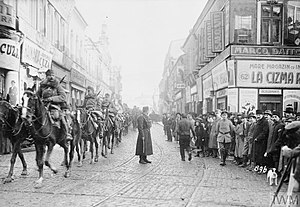
Back معركة بوخارست Arabic بوخارست دؤیوشو AZB Битка при Букурещ Bulgarian Μάχη του Βουκουρεστίου Greek קרב בוקרשט HE Bukaresti csata Hungarian Battaglia di Bucarest Italian ブカレストの戦い Japanese Slag om Boekarest Dutch Bitwa pod Bukaresztem Polish
| Battle of Bucharest | |||||||
|---|---|---|---|---|---|---|---|
| Part of the Romanian Debacle of the Romanian Campaign of World War I | |||||||
 Falkenhayn's cavalry entering Bucharest on 6 December 1916 | |||||||
| |||||||
| Belligerents | |||||||
|
|
| ||||||
| Commanders and leaders | |||||||
|
|
| ||||||
| Strength | |||||||
| 150,000 | 250,000 | ||||||
| Casualties and losses | |||||||
|
60,000 soldiers killed 85 artillery pieces 115 machine guns[1] | 10,000 soldiers | ||||||
The Battle of Bucharest, also known as the Argeş–Neajlov Defensive Operation in Romania, was the last battle of the Romanian Campaign of 1916 in World War I, in which the Central Powers' combatants, led by General Erich von Falkenhayn, occupied the Romanian capital and forced the Romanian Government, as well as the remnants of the Romanian Army to retreat to Moldavia and re-establish its capital at Iaşi.
The battle was of defensive nature, as the Romanian Army was joined by a part of the Imperial Russian army. The Romanian Army, led by General Constantin Prezan, had previously been unable to stop the German counterattack in Muntenia. The armed forces that made up the German counterattack were mostly German, two armed groups attacking concentrically, one from the direction of Oltenia and the other from the south of the Danube. The sheer number of troops involved, as well as the large area of operations, make it one of the most complex battles fought on Romanian soil during the war.
On 29 November 1916, Pitești was taken by the Central Powers.[2] On 4 December, the Danube Army, under general field marshal August von Mackensen's command – consisting of German, Bulgarian, Ottoman, and Austro-Hungarian troops – won the battle of Argeș.[3] As a result, Bucharest and Ploiești were occupied on 6 December by the Central Powers[4] On 11 December 1916, German and Austro-Hungarian troops crossed the Ialomița river.[5] During the night of 14–15 December, the Romanian forces retreated from Wallachia to Moldavia.,[6] marking a new moment in the war.
- ^ "Michigan War Studies Review" (PDF). Archived from the original (PDF) on 3 March 2016. Retrieved 6 March 2009.
- ^ "Pitesci – genommen," Neues Wiener Tagblatt, 30 November 1916, 1.
- ^ "Von den Kriegsschauplätzen," Neues Wiener Tagblatt, 5 December 1916, 1.
- ^ "Bukarest und Ploesci genommen," Neues Wiener Tagblatt, 7 December 1916, 1.
- ^ "Von den Kriegsschauplätzen", Neues Wiener Tagblatt, 12 December 1916, 1.
- ^ "Von den Kriegsschauplätzen", Neues Wiener Tagblatt, 16 December 1916, 1.
© MMXXIII Rich X Search. We shall prevail. All rights reserved. Rich X Search